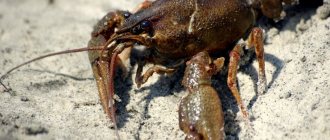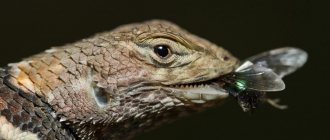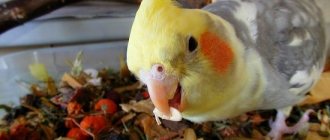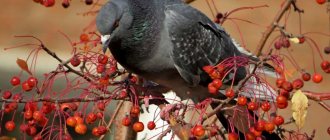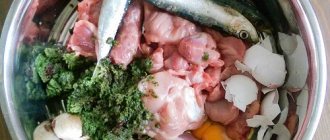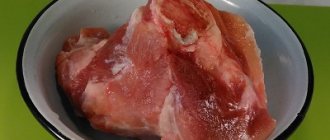Often when breeding crayfish, the question arises as to what crustaceans eat. Feeding crayfish is a responsible process that requires a serious approach. After all, their immunity, taste and further development depend on what arthropods eat. You cannot feed crayfish with any food. The article covers all the points related to feeding crayfish.
Peculiarities of crayfish nutrition during home breeding
You need to create a diet after determining the place where you plan to keep the crayfish.
In the pond
In a reservoir, arthropods consume natural food. These are plants, daphnia, small worms, rotifers. You should not rely on this menu being enough for the rapid development and reproduction of your wards. In any case, additional feeding will be required, otherwise the profit from the business will be insignificant.
To achieve marketable weight and size, crayfish are fed by installing feeders in the pond. They are preliminarily filled with pieces of bread, fish meat, vegetables, and oil production waste. In the evening, filled feeders are lowered to the bottom of the reservoir. Too much food should not be served; the leftovers will begin to decompose in the water, causing the environment to become polluted. This can cause the death of pond inhabitants.
Reference! To feed arthropods in the pond, you can use spinach leaves, soaked cereal grains, dandelions, lettuce and other garden crops.
The feeding period for invertebrates in the reservoir is from March to the second half of September or the first ten days of October. The timing is determined taking into account the water temperature. It should be about 10 degrees. When the temperature drops, feeding stops.
The daily ration rate is 0.5% of the live weight of the wards. In winter, there is enough food in the reservoir. Therefore, fertilizing is not carried out until spring.
In aquariums
When keeping arthropods in pools or an aquarium, you need to create a diet in such a way that it is as close as possible to the diet in the natural environment.
Specialized stores offer a large selection of food:
- pills;
- sinking granules;
- cereals, etc.
When choosing feed, preference is given to formulations enriched with calcium. This microelement promotes the rapid restoration of chitinous cover after a period of molting. You need to dilute the menu with spinach, cucumbers, and zucchini. If aquatic plants grow in the aquarium, the excess is also given to the crayfish as a treat.
Reference! At least once a week, fish fillets, shrimp or other frozen food should be added to the arthropod diet. This is a protein food necessary for rapid growth and weight gain.
The feeding regime in the aquarium is the same as in the pond - once a day. To create optimal conditions for keeping invertebrates, breeders equip the bottom of the tank with various stones and pots so that the crayfish can find shelter. On the one hand, this is correct, because adult individuals often arrange brutal fights among themselves. The victim has a chance to escape pursuit by hiding in a gorge of stones. On the other hand, food debris accumulates in secluded places, which speeds up the process of polluting the aquarium.
Feeding the young
The growing body of young crayfish requires a larger volume of varied food.
Before reaching a length of 2 cm, they require detritus - a product of the breakdown of organic matter. In nature, at the bottom of a reservoir, it is quite enough for young individuals. Due to constant filtration, there is not enough detritus in the aquarium.
Dry leaves of oak, alder or beech are used as feed. Not only young crayfish eat them, but also adults. Add leaves as you eat them. Do not use fresh leaves. They are capable of releasing a dangerous toxin into the water. Two-centimeter crustaceans begin to eat various insect larvae. From three centimeters of height, shellfish are included in the diet. Having reached 4 cm, the crustaceans begin to eat small fish.
You can feed young fish at home using food intended for fish fry. Aquarists advise adding small daphnia to the diet. Before being introduced into the aquarium, daphnia is scalded with boiling water to reduce mobility.
What do crayfish eat?
Under natural conditions, arthropods quickly find food thanks to their acute sense of smell. As the food decomposes, a distinct odor is formed, to which the crayfish rush. They can find food without difficulty, despite poor eyesight.
In the river, the diet includes algae, which are rich in lime. Calcium oxide is essential for a healthy shell. It is especially important to consume calcium-containing foods during the molting period, when the old armor falls off and a new one is formed in its place.
Algae that contain large amounts of lime: elodea, hornwort, charophyte varieties.
The natural body of water is home to potential prey:
- cyclops;
- Daphnia;
- snails;
- worms;
- larvae;
- tadpoles.
When growing crayfish in the river, farms carry out activities to breed zoo- and phytoplankton. This is an excellent food not only for arthropods, but also for their prey.
Crayfish in an aquarium
At a certain point, every aquarium owner has a desire to make it special, add some zest, get an unusual pet... The choice of many falls on crayfish, and for good reason! Crayfish not only have an expressive appearance and often bright colors. Their behavior, lifestyle, anatomical features, even their method of movement - all this is a never-ending source of inspiration! It's always interesting to watch them.
Even a simple doggystyle technique is a breathtaking sight!
Cancer can regrow lost limbs, mustaches, even claws!
Tropical and American crayfish are suitable for life in an aquarium, for example:
- Florida (California);
- Cuban;
- Louisiana;
- Mexican;
- Australian;
- marble.
Cold-water crayfish from Russian reservoirs are not suitable for aquarium keeping.
Contrary to popular belief, crayfish can coexist with fish, under certain conditions.
Keeping such an unusual pet in an aquarium surprisingly does not bring any additional trouble. Well, or almost doesn’t bring it. We will tell you the main points of maintaining and caring for a home cancer. About their proximity to fish. And of course, about what and how they eat.
Diet
Stocking up on food for crayfish is not difficult. You can purchase it at a specialty store or prepare it yourself. The main thing is that the diet is as close as possible to the diet in the natural habitat.
Menu close to natural conditions
In a river or pond you can often see crayfish fighting for the carcass of a decomposing fish. The acute perception of a pronounced smell and red color should be taken into account when compiling a home menu. Crayfish can mistake cereals and red vegetables for a piece of meat. They perceive anything green as algae. But such a replacement is not a complete diet.
This is due to the low or lack of calcium in the proposed substitutes. River algae are rich in lime, which is necessary for arthropods to restore their hard shell after molting. Therefore, they should definitely be included in the menu.
In addition to algae, it is necessary to supplement the diet with living creatures living in natural reservoirs. These are insect larvae, worms, daphnia, cyclops, etc. It is also appropriate to include amphipods and fish of various breeds in the diet.
Artificial feeding
In the absence of the opportunity to make maximum use of natural food for crayfish, attention is paid to the choice of ready-made food, which can be easily purchased in the store.
Arthropods are nocturnal, so it is worth laying the feeder in the evening. The menu includes:
- boiled and raw vegetables;
- combined feeds intended for herbivorous fish;
- minced meat (meat, fish).
Fatty foods should not be used. It is completely useless for crayfish, but it will spoil the water in no time. This often ends in a pestilence of the inhabitants.
When artificial feeding, it is recommended to include in the menu:
- rotten fish;
- spoiled meat;
- soaked cereals;
- fresh vegetable trimmings;
- worms;
- pieces of bread;
- young frogs;
- bloodworm.
Crayfish love spoiled food, but such food quickly pollutes the water. Therefore, breeders give this delicacy no more than once a week. It is recommended to serve food in a feeder. This makes it easier to remove the leftovers.
Types of feed
Crayfish are omnivorous, with the exception of products with synthetic and chemical additives. Feed can be either industrial or self-prepared.
Self-cooking
When creating your own diet, remember to balance animal and plant foods. Homemade food for crayfish includes:
- pieces of raw meat, chicken, fish;
- earthworms, maggots, bloodworms;
- a variety of vegetables;
- nettle;
- bread;
- seaweed.
Do not give crayfish fatty foods, which will pollute the water.
Industrial manufacturing
Release form: flakes, granules of different sizes or sticks. Regardless of appearance, the food chosen should be:
- balanced;
- do not pollute water;
- contain elements that facilitate molting.
Some types of feed are formulated specifically for different stages of cancer's life. There are varieties of complementary foods to stimulate reproduction, enhance the color of the shell, and strengthen the immunity of the fry.
How to feed crayfish correctly
The process of feeding arthropods is carried out in compliance with the following rules:
- Feeders should be laid in the evening;
- adhere to the daily feed intake, which directly depends on the live weight of the wards;
- during the period of cuticle shedding or reproduction, the amount of food is increased for rapid recovery after high energy expenditure;
- if there is not enough food, the crayfish begin to attack each other;
- when arranging an aquarium or pond, you need to provide places for shelter;
- the daily diet of young animals exceeds the norm for adults;
- The diet for individuals of different sexes is set individually (females are fed 1 day every 3 days, males - 1 day every 2 days);
- the shed cuticle is not removed; arthropods eat it to enrich the body with valuable calcium.
Diet during molting period
Molting is common for crayfish. Crustaceans grow throughout their entire life; due to the chitinous cover, this is not possible, because it is hard. Cancer needs it to be reset regularly. During molting, arthropods lose their activity and spend most of their time in shelter. If, instead of cancer, only its shell was seen, do not be alarmed, this is a natural process.
The chitinous cover is not removed - the cancer will eat it. After molting, young crayfish require a lot of calcium, which contributes to the rapid restoration of a new coating. In the first stages of their life, arthropods molt 5-6 times. After a few years, molting occurs several times throughout the year. The process itself lasts only 2-3 minutes. The new cover is completely restored in 1-1.5 weeks.
Before molting, it is necessary to increase the volume or frequency of feeding by approximately 4 times. It is allowed to feed crayfish with specialized food.
It is recommended to feed the following foods:
- pasta;
- shrimps;
- carrot;
- fish;
- porridge;
- worms;
- snails;
- meat;
- bloodworm;
- tubifex;
- coretra;
- Daphnia;
- gammarus.
Arthropods will also like a diet consisting of cabbage, lettuce, peas, parsley, zucchini, nettles, spinach, frozen vegetables, tree leaves, and even dry food for aquarium fish.
Feeders
You should not throw food for the inhabitants of an aquarium or pond directly into the water. It's better to buy a feeder. The store offers a wide range of products that differ in size and shape. The main factor determining the choice is the absence of toxic substances in the composition of the material.
The design of the feeder consists of a fixed platform on which the feed is placed, and fences. It can be made accessible to everyone using available means and materials. A sheet of wood or non-toxic plastic is taken as a basis, and the sides are fixed at the edges. That's it, the feeder is ready!
What kind of animal is that?
Before we talk about what crayfish eat, it’s worth getting to know these arthropod inhabitants of the water element. These animals belong to invertebrate crustaceans . There are many types, to name just a few of the most common:
- European;
- Far Eastern;
- Cuban;
- Florida;
- marble;
- Mexican dwarf, etc.
Crayfish are widespread across all continents. Their habitat is freshwater rivers, lakes, ponds and other bodies of water. Moreover, several species can live in one place at once.
Externally, cancer looks quite interesting.
It has two sections: cephalothorax and abdomen .
On the head there are two pairs of antennae and compound eyes. And the chest has eight pairs of limbs, two of which are claws. In nature, you can find crayfish of a wide variety of colors, from brown and green to bluish-blue and red. During cooking, all pigments disintegrate, leaving only red. It’s not for nothing that crayfish meat is considered a delicacy. In addition to its excellent taste, it contains virtually no fat, and therefore has low calorie content. In addition, meat contains many useful substances. There is calcium, iodine, vitamin E, and almost all B vitamins.
Interesting: How do hares live in the wild?
Frequency and volume of feedings
There is no clear food standard for arthropods. Breeders adhere to the following dosage: 0.5% of the live weight of crayfish. In this case, during the period of cuticle shedding or on the eve of reproduction, the amount of food is increased to 2-3% of live weight.
Reference! The feeder should be refilled only after it is completely empty. 2 days after feeding, the remains are removed to avoid rapid contamination of the environment.
It is impossible to determine a clear norm due to the following factors:
- females eat more food, but take longer to digest food;
- before breeding or changing the cuticle, crayfish consume more food than usual;
- As you get older, the need for energy replenishment decreases.
Features of feeding crayfish at home
The diet of river crustaceans in nature and when kept in an artificial environment are noticeably different. Aquarists need to know what and how to feed their pets in order to protect them from a number of diseases and rapid death.
Crayfish are omnivores, so problems with choosing food, as a rule, do not arise. Your pet's diet can include:
- bread crumbs;
- chopped pieces of meat of any kind;
- cereals;
- various cereals;
- pieces of fresh vegetables and fruits;
- greenery;
- nettle;
- earthworms.
In addition, you can purchase specialized food designed specifically for crustaceans, which are sold at any pet store.
The types of frozen or live food that are used to feed ornamental fish are ideal for crayfish, for example:
- small shellfish;
- cyclops;
- daphnia;
- rotifer.
Protein food is also necessary for crustaceans, but the basis of their diet should still be plant foods.
The most important thing is to monitor the portions of the food offered.
Experts recommend feeding food in a volume not exceeding 3% of the crayfish’s body weight.
Otherwise, the remains of uneaten food begin to rot and decompose, which leads to the death of arthropods.
Useful tips
Beginning businessmen who are planning to set up a farm for breeding crayfish are advised to take into account the advice of experienced breeders.
- When drawing up expenses for the year, you need to know that in the summer, crayfish need more food.
- If a tank with arthropods is installed outside, crayfish feeding stops from mid-autumn to spring.
- When growing in a pond, you need to periodically pay attention to cleaning the reservoir from turbidity. Turbid water provokes disease and extinction of inhabitants.
- The speed of weight gain and reproduction of the wards depends on the correct development of the diet.
- From the behavior of the crayfish, it becomes noticeable that negative changes are occurring in the water. Arthropods are inhabitants of clean water bodies.
- The water temperature, favorable for the intensive development of young animals and the reproduction process, should correspond to 15°.
The cost of maintaining a farm is significantly reduced with proper organization of the habitat and selection of balanced feeding.
Watch a video about feeding crayfish:
Care and maintenance - general principles
The main rule for keeping crayfish in an aquarium is the presence of clean, high-quality water, the condition of which is constantly maintained by a filter. An aerator and a heater are also essential assistants in caring for your arthropod pet.
A bright, large and healthy cancer will grow only with proper care.
| Volume of water (liters per 1 individual) | Temperature (°C) | Acidity (pH) | Hardness (dGH) |
| 70 | 20 – 26 | 5 – 8 | 8 – 12 |
One of the most important parameters of water for crayfish is its hardness, because in too soft water the animal’s shell slowly collapses, which will inevitably lead to its death.
Multi-apartment grotto for crayfish.
The soil in the crayfish house should be medium with a fraction size of 5 to 1.5 mm because arthropods arrange their own homes and love to dig holes. For the same reason, the aquarium must contain well-rooted aquatic plants, near which the crustacean can build a shelter for itself, and thanks to the root system of the plants, the hole will not collapse.
It is definitely worth equipping the aqua with decorative grottoes, which will also serve as a shelter for the secretive pet.
00:18
escape of a hermit crab from an aquarium
Crayfish are prone to escape, so the aquarium must be covered with a lid or glass. You won't believe how deftly these little guys can climb equipment and glass to escape the aquarium. Most often, escapes are arranged by pregnant females, in search of a place to give birth.
Taking care of you and your pets, Fish in a Jar.
Diseases
Like all living beings, crayfish are susceptible to various types of diseases. Most often, in such a situation, the owner of the arthropod himself is to blame. Dirty water, spoiled food, water temperature are the main factors that provoke diseases in crayfish.
Most often, these animals suffer from the following life-threatening diseases:
- Plague . The fungus enters the tissues of the animal's damaged skin and begins to multiply. The cancer first loses coordination, yellow spots appear on the shell, and after a few weeks death occurs;
- Burn disease . The causative agent of this disease is also a fungus. The shell of the crayfish becomes covered with spots.
When these diseases occur, infected crayfish must be immediately isolated, and all equipment must be disinfected using an alcohol solution.
When the first signs of illness appear, you should immediately contact a veterinarian.
What does a Cancer woman like?
Women of this sign love most to create harmony in relationships, mutual understanding in the family and comfort in the home. They are wonderful and hospitable housewives. Their home always smells like pies, is clean and cozy, and guests are happy to come to them for a generous portion of love and care. Cancer women love to take care of their bodies.
Interesting materials:
How to make a folder on Instagram? How to repost a story on Instagram? How to make a gift message on Instagram? How to do it on Instagram for fun? How to make text vertical in a compass? How to fill with an image in Corel? How to set marital status in Odnoklassniki from your phone? How to make a transparent background in Paint 3D? How to make a white background in paint? How to make an A4 sheet in power point?
Where and what kind to buy crayfish for the pond?
Experts advise keeping no more than 9 crayfish per 1 m² of pond. They can be purchased at special farms. Advertisements on the Internet will help you find the latest ones. It is very useful to ask if there are similar farms in your region, or maybe one of the summer residents or residents of nearby villages is already breeding these arthropods. Then you can buy “zoned” crayfish; they will definitely do well in your area.
When purchasing, you should take into account that in 1 season, 1 female is capable of laying up to 450 eggs (but on average this figure is 100). And only half of them will then hatch into crustaceans. That is, next year your number of cancers will increase on average 50 times (sometimes up to 200 times). But small crustaceans will need less space than adults (up to 300 individuals can live on 1 m²). This needs to be taken into account when you purchase your first crayfish.
As a rule, adult crayfish aged 3-4 years are bought for breeding (two females for one male). This is done in August-September. And in October they will begin the mating period. The cubs will appear in May-June. Already at the age of 20 days they will begin to feed on their own.
The most suitable for breeding crayfish in country ponds are long-fingered crayfish (narrow and long claws and a rough shell, body length 20 cm, male weight - more than 300 g) and broad-fingered crayfish (wide claws, smooth shell, body length about 15 cm).
Long-fingered crayfish (Pontostacus leptodactylus) live in natural conditions in the Moscow region, in the Middle Volga, and in the Astrakhan region. They are very prolific.
Broad-toed crayfish (Astacus astacus) live naturally in Northern Europe. They have a massive neck, abdomen, and paws, but grow very slowly.
Important! Only one breed of crayfish can be bred in one pond!
Long-fingered crayfish (Pontostacus leptodactylus). © BioLib
Broad-clawed crayfish (Astacus astacus). © Hezaurus
Compatibility of aquarium crayfish with fish
During all the time I have been observing aquarium crayfish, I have become convinced that they do not pose any threat to fish and plants. Aquarium crayfish can, to a limited extent and without damage, eat plants, pick up dead fish and attack sick ones, but aquarium crayfish are completely safe for healthy fish. One day, a goldfish in my aquarium got sick; its behavior was sluggish and it was increasingly at the bottom of the aquarium, resting its belly on the ground. Crayfish are good at noticing sick fish that will soon die.
Although the aquarium crayfish was much smaller than the goldfish, it still dragged it with all its might towards its hole. Having dragged the goldfish a sufficiently long distance, the fish broke free and swam away, and the crayfish crawled up to it again, grabbed the tail fin and dragged it to the mink. It is very interesting to observe this method of obtaining food in the life of crayfish.
Keeping two or three aquarium crayfish, for example, in a hundred-liter aquarium will not harm the landscape, fish and plants at all, but on the contrary, your aquarium will become livelier and much more interesting. So, if you decide to watch something really interesting in your aquarium, get aquarium crayfish. Well, now let's talk in more detail about keeping aquarium crayfish.
The benefits and harms of river arthropods
Crayfish have a lot of useful substances and vitamins. In addition, these animals live only in clean water, so they can be consumed without any fear.
Since arthropod meat contains a minimal amount of calories, it will be an excellent option for those on a diet. If you have problems with the kidneys, heart or gastric system, doctors recommend eating crayfish meat. This product will also help remove bile, cleanse the liver and serve as a preventative measure for the thyroid gland.
